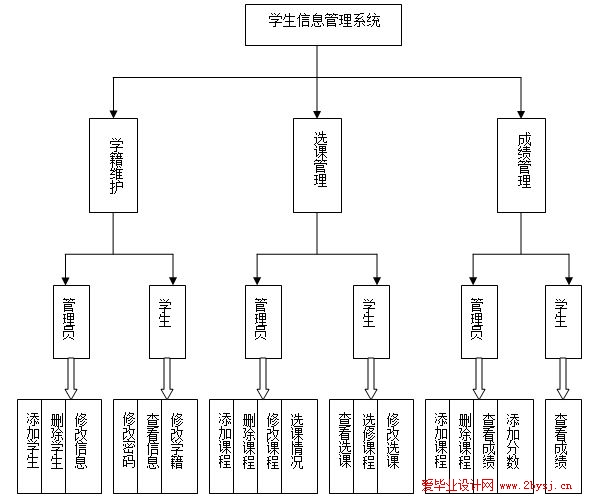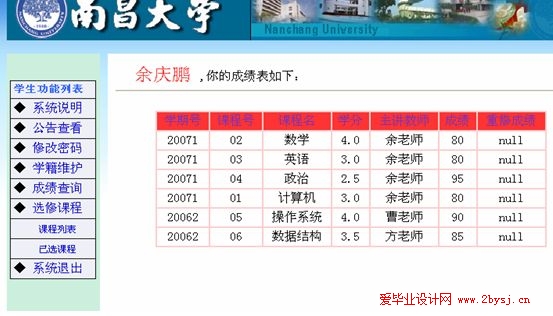学生信息管理系统的设计与实现
无需注册登录,支付后按照提示操作即可获取该资料.
摘 要
随着学校规模的不断扩大,学生数量急剧增加,有关学生的各种信息也成倍增长。面对如此庞大的信息量,开发学生信息管理系统来提高学生管理工作的效率就成为必然。通过该系统,可以做到信息的规范管理、科学统计和快速查询,从而减少管理方面的工作量。
本文主要介绍了学生信息管理系统的主要任务,阐述了开发该系统用到的关键技术,如采用B/S结构,使用JSP编程、利用SQLServer2000建立数据库、采用HTML,JAVAScript等编程技术。
本系统是采用B/S模式进行开发的,系统的用户权限有两种:学生和系统管理员,不同权限用户登入到不同的操作界面。该系统主要由学籍维护、选课管理、成绩查询等功能模块组成,本文具体介绍了各功能模块所包含的小模块的功能,学籍维护模块主要是对学生的基本信息进行添加、查询、修改、删除;选课管理模块主要是对选修的课程进行添加、删除、统计选修人数,以及学生进行选课和更改选课;成绩查询模块主要是对必修课进行添加、删除、录入成绩,以及学生进行查询成绩等功能。
关键字:学生信息管理,B/S,JSP,Script,SQLServer2000。
Based on JSP student information management system
Abstract
Along with the school scale unceasing expansion, the student quantity sharp growth, concerned student's each kind of information also becomes doubles the growth. Facing the so huge information content develops the student information management system to enhance the student supervisory work the efficiency to become inevitably. Through this system, may achieve the information the standard management, the science statistics and the fast inquiry, thus reduced management aspect work load.
This article mainly introduced the student information management system primary mission, elaborated develops essential technology which this system uses, like uses the B/S structure, uses the JSP programming, using the SQLServer2000 establishment database, uses HTML and JAVAScript, and so on programming technology.
This system uses the B/S pattern to carry on the development; the system user jurisdiction has two kinds: The student and the system manager, the different jurisdiction user records to the different operation contact surface. This system mainly by the school register maintenance, chooses function module and so on class management, result inquiry to be composed, this article specifically introduced various functions module contains the small module function, the school register maintenance module mainly is carries on the increase, the inquiry, the revision, and the deletion to student's basic information; Chooses the class administration module mainly is to the curriculum which takes as an elective carries on the increase, the deletion, the statistics takes as an elective the population, as well as the student carries on chooses the class and re-elects the class; The result inquiry module mainly carries on the increase, the deletion, the input result to the required course, as well as the student carries on function and inquiry result and so on.
本课题研究内容为学生信息管理系统,信息管理系统提供了强大的学生档案管理管理功能,方便管理员对学生信息的添加、修改、删除、查询等操作。本系统开发的总体任务是实现学生信息管理的系统化、规范化、自动化、达到提高学生信息管理效率的目的。
主要内容包过:
(1) 学籍维护模块:
1. 管理员可以对学生进行添加(包过基本信息)、删除、查看、修改信息。
2. 学生可以查看自己的基本信息,添加、修改详细个人信息。
(2) 选课管理模块:
1. 管理员可以对选修课程进行添加、删除、统计每门课程选修的人数以及查找
单个学生所选的课程。
2. 学生可以查看所有选修课程并进行选修以及查看自己所选课程并进行修改。
(3) 成绩管理模块:
1. 管理员可以进行添加、删除、修改基本课程,录入、修改学生基本课程成绩,
查找单个学生的所有成绩以及查找单门基础课程所有学生的成绩。
2. 学生可以查询自己的基础课程成绩。
学生信息管理系统主要提供方便高效的管理功能以及网上的信息查阅平台,学生可以通过该系统查阅相关信息、选课及修改相关信息,管理员可以管理所有信息。该系统使用JSP编程语言,Microsoft SQL2000数据库以及Apache Tomcat作为开发平台,运用软件工程思想方法,对系统进行快速有效开发, 系统分为以下几个方向:
(1)用户管理。实现对不同用户分配不同的权限。
(2)数据库连接。使程序能访问数据库,并能对其中的数据进行操作。
(3)数据录入。通过程序能实现往数据库中增加记录。
(4)数据查询。通过各种查询组合实现对数据的精确选取。
(5)数据维护。包括对数据的修改及删除操作。
系统依据Apache Tomcat构架的运行平台,利用Dreamweaver 进行整体框架的设计,连接数据库,最后进行全面的系统调试而完成。


目 录
摘 要 I
Abstract II
引 言 1
第一章 绪论 2
1.1 选题的背景和意义 2
1.2 国内外研究现状及发展趋势 2
1.3 本课题研究内容 2
1.4 本课题研究的目标及主要特色 3
第二章 系统设计使用技术介绍 4
2.1 JSP(Java Server Pages)和JAVA Bean技术介绍 4
2.1.1 JSP概述 4
2.1.2 JSP工作原理 4
2.1.3 JAVABean技术介绍 4
2.2 B/S体系结构介绍 5
2.3 JAVAScrit技术介绍 6
2.4 SQL Server 2000 数据库 6
2.4.1 数据库介绍 6
2.4.2 ODBC数据访问接口 7
2.4.3 JDBC数据访问接口 7
第三章 系统设计 9
3.1 需求分析 9
3.1.1 运行环境 9
3.2 系统总体设计 9
3.2.1 系统目标设计 9
3.2.2 系统设计思想 9
3.2.3 系统功能描述 10
3.2.4 系统用例图 12
3.2.5 系统UML活动图 13
第四章 数据库设计 14
4.1 总体表设计 14
4.2 数据库表的结构 14
4.3 实体及ER图 16
4.3.1 实体介绍 16
4.3.2 实体的ER图以及各实体之间联系的ER图 16
4.4 数据库表的关系图 19
4.5 数据库表的视图 20
4.6 数据库连接 20
第五章 系统具体实现 23
5.1 登入界面 23
5.2 学生界面 25
5.3 学生界面功能实现 26
5.3.1 查看公告页面 26
5.3.2 学生修改密码页面 26
5.3.3 学生学籍维护页面 28
5.3.4 成绩查询 30
5.3.5 查看学修课表并进行选修 30
5.4 管理员界面 32
5.5 管理员界面功能实现 33
5.5.1 查看学生基本信息 33
5.5.2 添加新学生和选修课 35
5.5.3 查看学修课表和必修课表 36
5.5.4 查看学生选课情况和学生成绩 37
5.5.5 添加必修课表和学生成绩 40
第六章 全文总结 44
致 谢 45
参考文献 46
